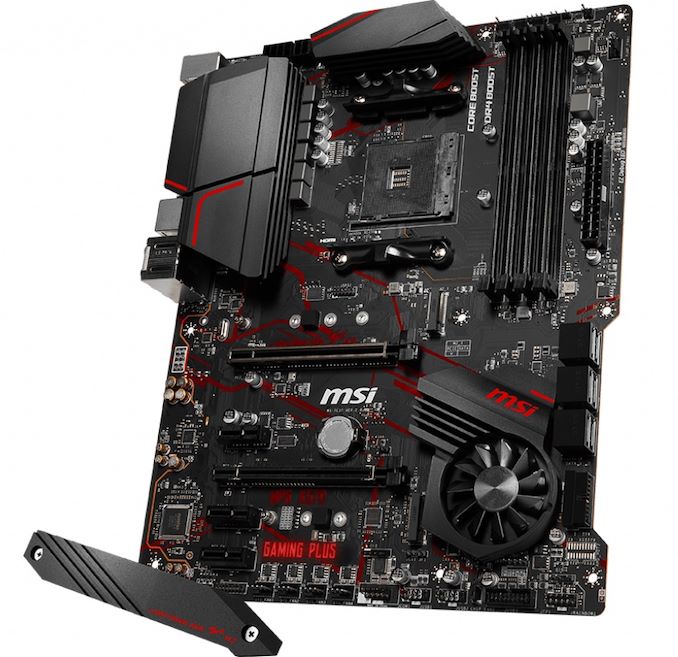The AMD X570 Motherboard Overview: Over 35+ Motherboards Analyzed
by Gavin Bonshor on July 9, 2019 8:00 AM ESTMSI MPG X570 Gaming Plus
The MPG X570 Gaming Plus is MSI's entry-level gaming model and It's equipped with a modest feature set which includes with one PCIe 4.0 x4 M.2 slots, and two-full length PCIe 4.0 slots with support for two-way AMD CrossFire multi-graphics card setups.
Firstly the aesthetic is based on a traditionally recognized red and black theme; this design extends from the heatsinks onto the PCB. The chipset heatsink cooling the X570 chip includes a cooling fan for optimal performance, while the power delivery heatsinks are separated from each other to provide cooling to the CPU VCore. There are 8-pin and 4-pin 12 V ATX CPU power inputs to delivery power to the processor, while the power delivery is running at 8+2 design with an International Rectifier IR35201 PWM controller.
Located in the top right-hand corner of the board are four memory slots which support DDR4-4400, with up to a maximum capacity of up to 128 GB. Moving down the PCB is two full-length PCIe 4.0 slots that operate at x16, and x16/x4, with an additional three PCIe 4.0 x1 slots. There are two PCIe 4.0 x4 M.2 slots, with one of the slots coming with a heatsink; there are also six SATA ports present.
On the rear panel are a single USB 3.1 G2 Type-A, one USB 3.1 G2 Type-C, four USB 3.1 G1 Type-A, and two USB 2.0 ports. A single HDMI video output gives the capability to use an AMD Ryzen APU, while a Flash BIOS button and a PS/2 combo port are also featured. Even MSI's entry-level gaming option includes the premium Realtek ALC1220 HD audio codec which provides five 3.5 mm audio jacks and S/PDIF optical output, while a Realtek RTL8111H Gigabit NIC controls the single Ethernet port.
The MSI MPG X570 Gaming Plus is the entry-level model to the X570 chipset from its product stack which also has a clear gaming look about it. With a red and black design, it's a throwback to MSI of more recent times, but the board has no integrated RGB which users may find slightly disappointing. The power delivery although adequate, probably isn't the best around for overclocking aRyzen 3000 processor to its limits, but with an MSRP of $169, it's horses for courses.












225 Comments
View All Comments
DigitalFreak - Tuesday, July 9, 2019 - link
I think the only advantage of using a 2000 series CPU with an X570 board will be PCIe 3.0/4.0 support. The X370/X470 only supported PCIe 2.0. In theory, the connection from the 2000 processor to the X570 chipset should run at PCIe 3.0 speeds.FreckledTrout - Tuesday, July 9, 2019 - link
The x370 chipset and x470 both supported PCIe 3.0 with either a 1xxx or 2xxx Ryzen CPU. If you are not running a 3xxx CPU in the x570 board there isn't any major feature that should cause one to want to upgrade.DigitalFreak - Tuesday, July 9, 2019 - link
@FreckledTrout - Yes and no. The interconnect between the CPU and the chipset is PCIe 3.0 on X370 / X470, but all the PCIe lanes that come off the chipset are 2.0. Running a 2000 series CPU in an X570 board would give you a PCIe 3.0 link between the CPU and the chipset, with either PCIe 3.0 or 4.0 lanes coming off the chipset (depends on if AMD drops everything to PCIe 3.0 with a 2000 series processor).extide - Tuesday, July 9, 2019 - link
It looks like they still allow the chipset lanes to be 4.0. So you'd have 3.0 link to cpu, but 4.0 from chipset to devices.Targon - Thursday, July 11, 2019 - link
Since you have at least one or two PCI Express slots that are connected to the CPU, not chipset, that almost becomes a non-issue. On my Asus ROG Crosshair VI Hero(X370), you have PCI Express 3.0 x16 for the first slot, or x8/x8. The third PCI Express x16 slot is a 2.0 I believe, which is still enough to get the job done for many devices. Even with the X570 board with a first or second generation Ryzen processor, the most you end up with is an extra 3.0 supporting slot. Note that many boards may have x16 slots, but they are x8 electrically, so you won't see the full bandwidth anyway in those slots.sorten - Tuesday, July 9, 2019 - link
Thanks Gavin! This is a great resource and is exactly what I needed to help build my new system.willis936 - Tuesday, July 9, 2019 - link
The return of the 40mm fan! Those are the most obnoxious components ever. No one has missed them in the past ten years.Kastriot - Tuesday, July 9, 2019 - link
Buy Asrock aqua and problem solved.FreckledTrout - Tuesday, July 9, 2019 - link
I'm waiting for the next iteration of board for this reason. I'm speculating the next round the chipset will be on 7nm.abufrejoval - Tuesday, July 9, 2019 - link
The genious about that chiplet design is that the chipset doesn't actually benefit nearly as much from the shrink, as pure logic or SLC caches: The monolithic guys pay the 7nm overhead (e.g. EUV) for I/O while the geometry of the transistors in the I/O area is mostly determined by the need to power long motherbord or even slot traces.So while waiting is never a bad idea when your need clearly isn't overwhelming you, waiting for that shrink could turn out rather long. These days I/O heave chips might never be done in smaller geometries, because of that and because packaging has matured.